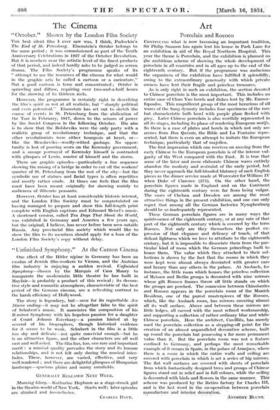Art
Porcelain and Rococo
CONTINUING what is now becoming an important tradition, Sir Philip Sassoon has again lent his house in Park Lane for an exhibition in aid of the Royal Northern Hospital. This year the theme is Porcelain, and the exhibition is planned on the ambitious scheme of showing the whole development of porcelain in all countries and in all ages up to the end of the eighteenth century. But if the programme was audacious the organizers of the exhibition have fulfilled it splendidly, owing to the extraordinary generosity with which private owners have lent their fragile and priceless treasures.
As is only right in such an exhibition, the section devoted to Chinese porcelain is the most important. This includes an entire case of Chun Yao bowls and dishes lent by Mr. Eumor- fopoulos. This magnificent group of the most luxurious of all wares of the Sung dynasty includes four specimens of the rare but characteristic bulb bowl with purple glaze flecked with grey. Later Chinese porcelain is also worthily represented in all its stages, including its phase of rendering European motifs. So there is a case of plates and bowls in which not only are scenes from Don Quixote, the Bible and La Fontaine repre- sented, but there is even an attempt to imitate the European technique, particularly that of majolica.
The first impression which one receives on moving from the early Chinese to the European porcelain is of the intense vul- garity of the West compared with the East. It is true that some of the later and more elaborate Chinese wares entirely abandon the modesty and restraint of the early period, but they never approach the full-blooded blatancy of such English pieces as the dinner service made at Worcester for William IV when Duke of Clarence (275). On the other hand, the porcelain figures made in England and on the Continent during the eighteenth century were far from being vulgar. The cases of Chelsea and Dresden are among the most attractive things in the present exhibition, and one can only regret that among all the German factories Nymphenbutg should be so inadequately represented.
These German porcelain figures are in many ways the quintessence of the eighteenth century, or at any rate of that part of the eighteenth century which is covered by the term Rococo. Not only are they themselves the perfect ex- pression of that elegance and delicacy of touch, of that defiant lightness which we love to attribute to the eighteenth century, but it is impossible to dissociate them from the par- ticular kind of room which the German princelings built to house them. The value which they attached to their col- lections is shown by the fact that the rooms in which they were kept were almost always decorated with greater care and luxury than any others in the palace. At Ansbach, for instance, the little room which houses the priceless collection of Meissen and Berlin groups is decorated with nine mirrors whose gilt Rococo frames throw off little stands on which the groups are perched. The connexion between Chinoiseries and Rococo appears in the porcelain room of the Munich Residenz, one of the purest masterpieces of the Rococo, which, like the Ansbach room, has mirrors covering almost all its wall surface. Above and between these mirrors are little ledges, all carved with the most refined workmanship, and supporting a collection of rather ordinary blue and white Chinese porcelain. Here the architect, Cuvillies, has merely used the porcelain collection as a stepping-off point for the creation of an almost unparalleled decorative scheme, built up round the porcelain but possessing a far more permanent value than it. But the porcelain room was not a feature confined to Germany, and perhaps the most remarkable example of it occurs in Spain; in the palace of Aranjuez, where there is a room in which the entire walls and ceiling are covered with pOrcelain in which is set a series of big mirrors. The flat wall surfaces are covered with sheets of porcelain from which fantastically designed trees and groups of Chinese figures stand out in relief and in full colours, while the ceiling is decorated with birds and flowers in the same manner. This scheme was produced by the Retiro factory for L'harles and is the last word in the CO-Operaiion between pOreelain Manufacture and interior decoration. "• ANTEM4t










































 Previous page
Previous page